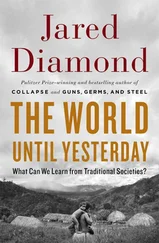Jared Diamond - Guns, Germs & Steel
Здесь есть возможность читать онлайн «Jared Diamond - Guns, Germs & Steel» весь текст электронной книги совершенно бесплатно (целиком полную версию без сокращений). В некоторых случаях можно слушать аудио, скачать через торрент в формате fb2 и присутствует краткое содержание. Жанр: 105. Описание произведения, (предисловие) а так же отзывы посетителей доступны на портале библиотеки ЛибКат.
- Название:Guns, Germs & Steel
- Автор:
- Жанр:
- Год:неизвестен
- ISBN:нет данных
- Рейтинг книги:5 / 5. Голосов: 1
-
Избранное:Добавить в избранное
- Отзывы:
-
Ваша оценка:
- 100
- 1
- 2
- 3
- 4
- 5
Guns, Germs & Steel: краткое содержание, описание и аннотация
Предлагаем к чтению аннотацию, описание, краткое содержание или предисловие (зависит от того, что написал сам автор книги «Guns, Germs & Steel»). Если вы не нашли необходимую информацию о книге — напишите в комментариях, мы постараемся отыскать её.
Guns, Germs & Steel — читать онлайн бесплатно полную книгу (весь текст) целиком
Ниже представлен текст книги, разбитый по страницам. Система сохранения места последней прочитанной страницы, позволяет с удобством читать онлайн бесплатно книгу «Guns, Germs & Steel», без необходимости каждый раз заново искать на чём Вы остановились. Поставьте закладку, и сможете в любой момент перейти на страницу, на которой закончили чтение.
Интервал:
Закладка:
I 6 6 • GUNS, GERMS, AND STEEL
of the last Ice Age. As summarized in Table 9.3, the era of big mammal domestication began with the sheep, goat, and pig and ended with camels. Since 2500 b.c. there have been no significant additions.
It's true, of course, that some small mammals were first domesticated long after 2500 b.c. For example, rabbits were not domesticated for food until the Middle Ages, mice and rats for laboratory research not until the 20th century, and hamsters for pets not until the 1930s. The continuing development of domesticated small mammals isn't surprising, because there are literally thousands of wild species as candidates, and because they were of too little value to traditional societies to warrant the effort of raising them. But big mammal domestication virtually ended 4,500 years ago. By then, all of the world's 148 candidate big species must have been tested innumerable times, with the result that only a few passed the test and no other suitable ones remained.
Still a fourth line of evidence that some mammal species are much-more suitable than others is provided by the repeated independent domestications of the same species. Genetic evidence based on the portions of our genetic material known as mitochondrial DNA recently confirmed, as had long been suspected, that humped cattle of India and humpless European cattle were derived from two separate populations of wild ancestral;! cattle that had diverged hundreds of thousands of years ago. That is, Indian peoples domesticated the local Indian subspecies of wild aurochs, Southwest Asians independently domesticated their own Southwest Asiaiy subspecies of aurochs, and North Africans may have independently domesticated the North African aurochs.
Similarly, wolves were independently domesticated to become dogs ii the Americas and probably in several different parts of Eurasia, includii China and Southwest Asia. Modern pigs are derived from independent! sequences of domestication in China, western Eurasia, and possibly other| areas as well. These examples reemphasize that the same few suitable wild ] species attracted the attention of many different human societies.
ihe failures of modern efforts provide a final type of evidence 1 past failures to domesticate the large residue of wild candidate s[ arose from shortcomings of those species, rather than from shortcot
ZEBRAS ANDunhappy MARRIAGES • 167
table 9.3 Approximate Dates of First Attested Evidence for Domestication of Large Mammal Species
Species
Date (b.c.)
Place
Dog
10,000
Southwest Asia, China,
North America
Sheep
8,000
Southwest Asia
Goat
8,000
Southwest Asia
Pig
8,000
China, Southwest Asia
Cow
6,000
Southwest Asia, India,
(?)North Africa
Horse
4,000
Ukraine
Donkey
4,000
Egypt
Water buffalo
4,000
China?
Llama / alpaca
3,500
Andes
Bactrian camel
2,500
Central Asia
Arabian camel
2,500
Arabia
For the other four domesticated large mammal species—reindeer, yak, gaur, and ban-teng—there is as yet little evidence concerning the date of domestication. Dates and places shown are merely the earliest ones attested to date; domestication may actually have begun earlier and at a different location.
of ancient humans. Europeans today are heirs to one of the longest traditions of animal domestication on Earth—that which began in Southwest Asia around 10,000 years ago. Since the fifteenth century, Europeans have spread around the globe and encountered wild mammal species not found in Europe. European settlers, such as those that I encounter in New Guinea with pet kangaroos and possums, have tamed or made pets of many local mammals, just as have indigenous peoples. European herders and farmers emigrating to other continents have also made serious efforts to domesticate some local species.
In the 19th and 20th centuries at least six large mammals—the eland, moose, musk ox, zebra, and American bison—have been the subjects especially well-organized projects aimed at domestication, carried out modern scientific animal breeders and geneticists. For example, eland, argest African antelope, have been undergoing selection for meat quality and milk quantity in the Askaniya-Nova Zoological Park in the
I 6 8 • GUNS, GERMS, AND STEEL
Ukraine, as well as in England, Kenya, Zimbabwe, and South Africa; an experimental farm for elk (red deer, in British terminology) has been operated by the Rowett Research Institute at Aberdeen, Scotland; and an experimental farm for moose has operated in the Pechero-Ilych National Park in Russia. Yet these modern efforts have achieved only very limited successes. While bison meat occasionally appears in some U.S. supermarkets, and while moose have been ridden, milked, and used to pull sleds in Sweden and Russia, none of these efforts has yielded a result of sufficient economic value to attract many ranchers. It is especially striking that recent attempts to domesticate eland within Africa itself, where its disease resistance and climate tolerance would give it a big advantage over intro-1 duced Eurasian wild stock susceptible to African diseases, have not caught;; on.
Thus, neither indigenous herders with access to candidate species ove thousands of years, nor modern geneticists, have succeeded in making \ ful domesticates of large mammals beyond the Ancient Fourteen, were domesticated by at least 4,500 years ago. Yet scientists today couJdB undoubtedly, if they wished, fulfill for many species that part of the defini*! tion of domestication that specifies the control of breeding and food ply. For example, the San Diego and Los Angeles zoos are now subjecting the last surviving California condors to a more draconian control of ing than that imposed upon any domesticated species. All individual cc dors have been genetically identified, and a computer program determir which male shall mate with which female in order to achieve human go (in this case, to maximize genetic diversity and thereby preserve endangered bird). Zoos are conducting similar breeding programs many other threatened species, including gorillas and rhinos. But the ; rigorous selection of California condors shows no prospects of yielding|0 economically useful product. Nor do zoos' efforts with rhinos, althou rhinos offer up to over three tons of meat on the hoof. As we shall see, rhinos (and most other big mammals) present insuperable obstacles I domestication.
Интервал:
Закладка:
Похожие книги на «Guns, Germs & Steel»
Представляем Вашему вниманию похожие книги на «Guns, Germs & Steel» списком для выбора. Мы отобрали схожую по названию и смыслу литературу в надежде предоставить читателям больше вариантов отыскать новые, интересные, ещё непрочитанные произведения.
Обсуждение, отзывы о книге «Guns, Germs & Steel» и просто собственные мнения читателей. Оставьте ваши комментарии, напишите, что Вы думаете о произведении, его смысле или главных героях. Укажите что конкретно понравилось, а что нет, и почему Вы так считаете.










